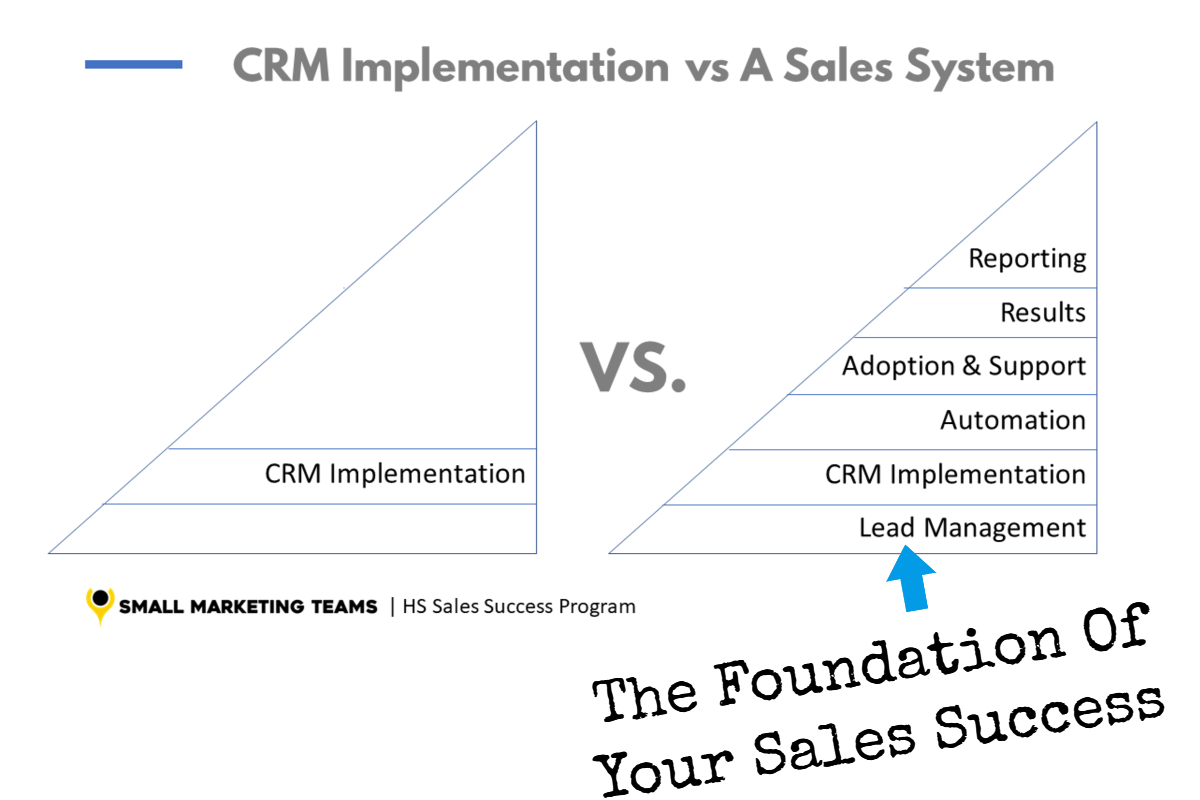Your lead management process must include the following 5 elements:
The Role Of Lead Management In Growing Your Business
Who doesn’t love inbound leads?
Inbound leads are amazing.
You create helpful, insightful, educational, and original content for your market, and people find you.
Next, they request a demo, take a product tour, download an eBook, cheat sheet, or checklist, and then enter your marketing and sales system as leads.
Unfortunately, most salespeople don’t know what to do with them. In fact, converting leads at the top and middle of the funnel is problematic for most organizations.
In the following video and article, we’ll explore how your lead management process can serve two very important purposes.
First, it helps your sales team close more leads, and secondly, it works to surface what is working and what is not within your sales process.
What is Lead Management (And Why Should You Care)?
During my first year using HubSpot to generate inbound leads at a B2B software company, I consistently generated 100 leads a month (up from 10 leads per month).
I was very excited about these results. I had HubSpot set up. I had leads coming in. I had the data and metrics. I had everything working. I was pushing a lot of leads over to sales.
After that first year, I walked into my review meeting with the executive partners with a lot of swagger, subtly gloating about what I had done.
I sat across from the rest of the executive team and got one of the biggest shocks of my life.
They said, “Josh, I don’t think this is going to work out.”
I was completely blindsided and devastated. I was at a point in my career where I felt like I was finally contributing.
The problem was that none of those inbound leads I had passed over to sales had turned into revenue.
Fortunately, the executive team kept me around and gave me one more chance. I had to make it work. I had to find a way to get the sales team to convert those leads into customers.
I purposely put less time into generating leads and became a student of B2B sales.
Video: The Biggest Problem With Inbound Lead Generation
I had to figure out how to get the sales team excited about working inbound leads, which enter during different stages of the sales process (unlike “contract-ready” ready-for-a-demo leads).
The Beauty of Inbound Marketing For Increasing Sales
When you implement inbound lead generation, you expand your lead pool to include people who are researching their problem and looking for information about solutions. This allows you to build those relationships sooner, instead of just talking to people who are ready to buy. While the sales conversations are different, you’re getting many more leads.
Since that time, I’ve become an authority on lead management. This is where I’ve spent the bulk of the past few years. Rather than helping people on the traffic and lead generation side, I help companies set up business-specific lead management processes.
Why, you might ask?
I know firsthand that you can generate tons of traffic and hundreds of leads each month, but your business won’t grow if the leads are rotting on the vine and slipping through the cracks.
That’s the whole purpose behind lead management: preventing good leads that you are investing in from going to waste.

Lead management is the process of knowing:
- What to do with leads
- Where they go in your CRM
- What data gets changed
- How to track and follow up with leads
- How to know where they are in the sales process
- How to spend your time selling, instead of entering data into your CRM
Anyone from your team should be able to go into the system, look at a lead, and know exactly where that lead is in your process.
Pillars of Lead Management
There are a few things you need to focus on in order to create a strong lead management process that will turn leads into revenue.
Pillar #1) Definitions
These are clear, agreed-upon, company-wide definitions for lead statuses, lifecycle stages, and how you track next actions (such as initially connect with the lead or schedule a demo). Your lead management definitions also include the criteria for getting a lead onto the deal board, definitions for all of the deal stages, as well as definitions for lead status.
Why is this critical for your “lead to sale” conversion rate? First, everyone must be playing from the same playbook. Don’t make your sales reps guess at the definitions in your CRM or create their own process. Most importantly, it also helps to keep your data clean and consistent.
Pillar #2) Process
When a lead comes in, how does it get routed?
What are the steps that the salesperson takes to connect with that lead? If they connect with them, where does it go?
What happens if a lead is qualified, but not yet ready to talk to sales?
What are all the scenarios that you need to be able to accommodate at every point in the sales process?
You must map all of that out. Your lead management process will be deep and complicated in order to make it as simple as possible for your sales reps. The last thing you want is to miss a key scenario and leave your sales reps to figure out their process on the fly.
Pillar #3) Automation
When most people think of automation, they think of marketing automation, but there is a tremendous amount you can do with automation on the sales side as well.
Automation can help sales reps be hyper-efficient by touching as few fields as possible on the back end. It can also help your lead management framework stay intact, your reporting accurate, and your data stay clean.
Pillar #4) Accountability
Set up accountability so that your sales team understands their responsibilities. More specifically, they need to know which metrics they’ll get dinged on by their sales manager and which will have an automatic reminder within the system.
Since your data is clean and people are mapping their sales process to the lead management structure built into your CRM, sales reps will have a clear picture of their accountabilities.
Without the definitions, process, and automation, it’s too easy for salespeople to fudge their numbers. It’s not their fault; it’s due to the lack of a lead management process built into the system.
Pillar #5) Reporting
When you have your definitions and your process, the data you need to make faster, better decisions comes into focus.
Your managers and executives get to step out of the technology and convey what they would like to see and report on. If you already have your data structured that way, with a lead management process in place, you’re able to get that reporting and make it part of their process.
Before they go into a sales meeting, your managers and executives will know exactly which reports they need to see. Conversely, they’d have no data to refer to without a lead management process in place.
Now they will know exactly what to focus on and everyone will be on the same page. This helps make accountability a lot easier.
Lead Management Takeaway
Lead management is essential to B2B companies and businesses that have a non-transactional sales process.
If you have the concept of a lead or there is a “considered sales process” in your buyer’s journey, you always have the risk of leads piling up very quickly when you scale lead generation.
You need a simple way of being able to identify where people are in the process, who you need to call, what you need to call them about, and when to do it.
You can look at your whole week that way, regardless of how many leads are assigned and at what point they’re in the process.
You need a way to route and work leads without overwhelming your salespeople. When your salespeople get overwhelmed, they stop following up with those leads and stop closing. When the salespeople stop closing, it’s usually the marketing department who gets blamed.


